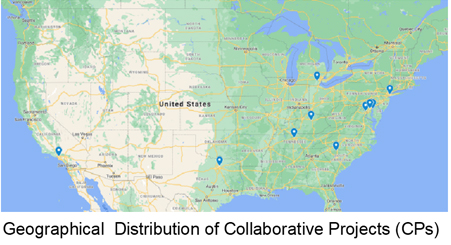 In order to properly perform modern MRI and MRS of disease and develop biomarkers that can ultimately contribute to personalized medicine, it is of essence to combine the expertise of physicists, translational scientists and clinicians. It is fair to say that it is almost impossible for a single scientist to perform all aspects of such complex research. MRI is uniquely suited to translate newly developed methodologies directly to patient care. However, this does not always happen because of lack of interaction between basic scientists and clinicians or an improper understanding of clinical needs by the physicists and engineers. Our proposed Center is dedicated to translating the new biomarker technology into clinical practice. For this we need close collaboration with leading clinicians and scientists throughout the nation (see map). With this in mind, the recruitment criteria for a collaborative project are that the NIH-funded investigators study diseases for which our technology is expected to be beneficial and who can provide expert feedback leading to new ideas that can further our technologies with the purpose of better assessing multiple disease aspects. If you are interested in becoming a collaborative project, please apply to Dr. van Zijl or Dr. Lu (contact us page).
In order to properly perform modern MRI and MRS of disease and develop biomarkers that can ultimately contribute to personalized medicine, it is of essence to combine the expertise of physicists, translational scientists and clinicians. It is fair to say that it is almost impossible for a single scientist to perform all aspects of such complex research. MRI is uniquely suited to translate newly developed methodologies directly to patient care. However, this does not always happen because of lack of interaction between basic scientists and clinicians or an improper understanding of clinical needs by the physicists and engineers. Our proposed Center is dedicated to translating the new biomarker technology into clinical practice. For this we need close collaboration with leading clinicians and scientists throughout the nation (see map). With this in mind, the recruitment criteria for a collaborative project are that the NIH-funded investigators study diseases for which our technology is expected to be beneficial and who can provide expert feedback leading to new ideas that can further our technologies with the purpose of better assessing multiple disease aspects. If you are interested in becoming a collaborative project, please apply to Dr. van Zijl or Dr. Lu (contact us page).
Our Collaborative Projects are:
2/21 ABCD-USA Consortium: Research Project Site at UMB
Linda Chang, M.D. and Thomas Ernst, Ph.D., University of Maryland Baltimore (UMB
Cerebrovascular reserve and white matter disease in patients with anemia
John Wood, M.D., Children's Hospital of Los Angeles
Contributions of Alzheimer's pathology and cerebrovascular factors to cognitive aging
Brian Gold, M.D., University of Kentucky.
Dallas lifespan brain study-wave 3: neurodegeneration & resilience in cognition
Denise Park, Ph.D., University of Texas, Dallas
Imaging framework for testing GABAergic/glutamatergic drugs in bipolar alcoholics
James Prisciandaro, Ph.D., Medical University of S. Carolina.
Mechanisms of age-related white matter hyperintensities (WMHs): insights from advanced MRI
Yulin Ge, Ph.D., New York University.
Preclinical Alzheimer’s Disease (AD) consortium
Marilyn Albert, Ph.D., Johns Hopkins University
Quantitative imaging of brain glymphatic function in humans
Manus Donahue, Ph.D., Vanderbilt University
Subtle motor functioning and functional connectivity in youth medically cleared after mild TBI
Stacy Suskauer, M.D., Kennedy Krieger Institute
University of Michigan fibromyalgia (FM) CORT. Pain Mechanisms
Richard Harris, Ph.D., University of Michigan at Ann Arbor
